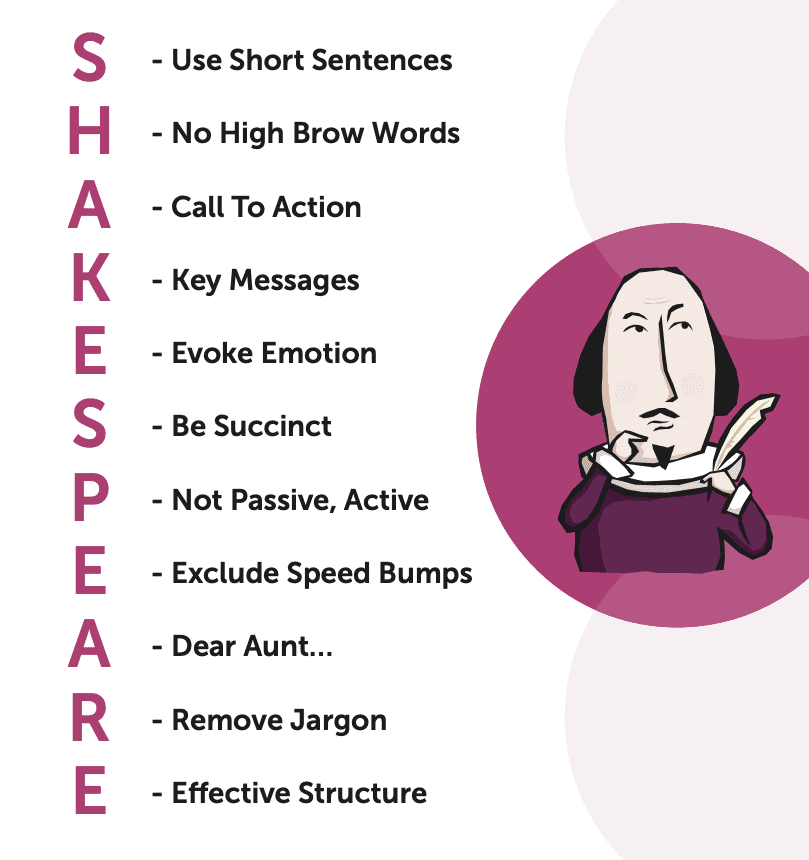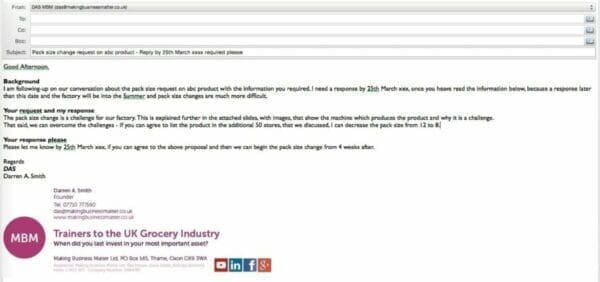Use S.H.A.K.E.S.P.E.A.R.E. to Improve Your Written Communication Skills with
In today’s busy world, written communication skills are a must. Alex understood this. Poor writing made emails long and pointless, confused important reports, and could mean missed chances.
Given a key report to write, Alex worked hard on each sentence. Their clear, brief words had power. Also, at the presentation, the bosses were impressed.
Even more, an email came asking about adding a team member and Alex’s simple and strong reply closed the deal. At work, people saw Alex as a great communicator. This showed that getting good at writing was important for success.
With that said, here are 11 Tips to Improve Your Written Communication Skills and help you to write more effective emails and reports. It’s easy to remember too, just think ‘SHAKESPEARE’.

S – Use SHORT Sentences
The UK Government does not write sentences longer than 25 words. The writing expert Ann Wylie suggests that at 14 words the reader achieves 90% comprehension. Moreover, at 43 words that understanding reduces to 10%. 14 words are the average number of words on a row in a Microsoft Word document at font 12.
Action: Use shorter sentences. 14 words are optimum. One to two rows on a Microsoft Word document.
H – No HIGH Brow Words
We all have at least a few high brow words that we could use. We learnt them from a colleague or a boss. Then we researched them and now know what they mean. It makes us feel good to use them. My advice is don’t. In short, it is poor written communication skills. You’re failing to communicate in the simplest way.
A colleague uses ‘juxtaposition’. When I first heard it I had to find out what it meant, though I’d got the gist from the conversation. It means ‘the fact of two things being seen or placed close together with contrasting effect’. In my words, it’s about opposites. We could use simpler language to explain it without having to use that word. Sometimes you’ll need to use a word that has no replacement. However, try to use these sparingly.
Action: Avoid using high brow words. Use simple language instead.
A – Call To ACTION
Those people that create websites, marketing copy, and advertising, want us to do something. They know what they want us to do. It is very clear. One of the first things that they do is to identify what they want us to do.

Above is a ‘Landing Page’ for one of our reports. We have made the ‘Call To Action’ very clear because not only do you know what we want, to (enter your email address), it is also the only option that you have!
Action: Decide what you want your reader to do. Be very clear on the actionable next step that you want them to take having read your email/report.
K – KEY Messages
How often have you read an email and then read it again? Why did you have to re-read it? I’d guess that it’s because the writer wasn’t clear on the key message. In short, they didn’t really know what they were trying to say. They demonstrated poor written communication skills. If you’re not clear in what you are saying, then don’t be surprised if the reader isn’t clear either! Identify what your key message is. Say it loud. Write that message down before you start.
For instance, if you are looking for more resources, make sure you make this message clear in your email/report. Write it down, use it as the subject – ‘Agreement to funding for one more person’.
If you are communicating more than one message say each one loudly and proudly. However, as a rule, you should never have more than 3 key messages.
Action: Before you start to write, write your key messages/s on a separate piece of paper to remind you.
E – Evoke EMOTION

Your report or email needs to ‘stir’ the person. Unlike the newspaper headline above, unless it was stirring them into boredom. You don’t want your reader to end thinking, ‘So what?’, or ‘Who cares?’. You want to capture their attention and emotion. Do you want to motivate them to action because they are proud to share the report? Maybe they are angry to forward the email? Or, just excited to use the text?
One of the most famous The Sun newspaper headlines was, ‘Freddie Starr Ate My Hamster’. For me this stirred, ‘Ewwww, How could he?!’. But, it got an emotional reaction and my attention.
Action: Which emotion do you want to store in your reader?
S – Be SUCCINCT
The dictionary definition of ‘succinct’ as to be brief and clearly expressed. There is a famous phrase that is useful to keep in mind, ‘I’m sorry I wrote a long report, but I didn’t have time to write a short one’. A fabulous quote because it sums us up. So often we just write a lengthy document of our thoughts rather than deciding what we really need to say.
It’s hard to be succinct. It relies on knowing what we want the reader to take away.
Action: If you have written a lengthy report, be brutal with your editing. Delete. Re-write paragraphs. Volume does not equal comprehension.
P – Not PASSIVE, Active
This article by Quick and Dirty Tips explains the active and passive voice very well.
What is Active Voice?
I’ll start with the active voice because it’s simpler. In an active sentence, the subject is doing the action. A straightforward example is this short sentence:
‘Steve loves Amy.’
Steve is the subject, and he is doing the action. He loves Amy. Amy is the object of the sentence.
Another example is the title of the Marvin Gaye song ‘I Heard It Through the Grapevine.’ In this instance, ‘I’ is the subject, the one who is doing the action. ‘I’ is hearing ‘It’, the object of the sentence.
What is Passive Voice?
With passive voice, the target of the action gets promoted to the subject position. For instance, instead of saying:
‘Steve loves Amy’, the passive version is ‘Amy is loved by Steve’.
The subject of the sentence becomes Amy, but she isn’t doing anything. Rather, she is just the recipient of Steve’s love. The focus of the sentence has changed from Steve to Amy.
An example in business would be:
Passive – ‘At a cost of £x per annum for the ABC team hiring one extra person is my recommendation’.
Active – ‘I recommend hiring one additional person for the ABC team at a cost of £1x per annum is my recommendation.’
Action: Using your active voice is essential for good written communication skills. You will engage your reader much more if you understand how to write using your active voice.
E – EXCLUDE Speed Bumps
You’re driving. Pleasant enough journey. Chatting to your wife and kids. Then the car jumps, you’ve hit a speed bump. You have jolted away from what you were talking about. You’re now concentrating a little harder on getting over the next speed bump and the one after that until they finish. Writing is the same. A speed bump in writing does the same. It jolts you out of the flow and opens your reticular filter to look for more speed bumps.
An example of writing speed bumps could be a spelling error, poor grammar, page numbers not in the right order, using words wrongly, jargon, or bullet points that don’t all start with a verb.
Action: Stop trying to sound smart, you will make fewer mistakes. Remove speed bumps from your writing as you write and when you review your piece afterwards.
A – Dear AUNT…
Write as if you are writing to your Aunt. When we read material written in a conversational style that mentions I and you, it talks to us directly. This makes communication very real and personal. We pay attention just the same as if we were having a face to face conversation.
Most of us have been brought up to believe that business language is stiff and formal. That we must adopt a different style to get our business message across. Just like our advice when you go to a meeting – Be yourself. When writing, my advice is to always be yourself. Just ensure that you are credible because spelling and grammatical mistakes still annoy many.
Action: Write as though you are writing to a good business friend as you sit and have coffee.
R – REMOVE Jargon
Every industry has its jargon. Yes, there’s a lot of it. Some people even pride themselves on knowing it all and using it wherever they can.
In the TV series Spooks, there is a wonderful piece of the script where the US Secret Service are overly suspicious about their President’s visit to the UK. They spill into Secret Service Military jargon about ‘Hot LZ’s’, ‘Bolo’, and ‘Black bag’. Then MI5 nicely expose them for being jargon assessed.
Action: The best option is not to use jargon because you cannot assume that everyone knows it.
E – EFFECTIVE Structure
When trying to develop my written communications skills at school, I was taught by Mr Clifford, my English teacher. He would often ask, ‘Smith – where is the middle? You have only a start and an end’. Did I say ‘taught’?! At the very least your report needs a start, middle and an end.
To have an effective structure you need to break your report into sections. The brain can manage 7’s really well and little beyond 7. So, I suggest having a maximum of 7 sections. Those sections should be numbered or lettered to make it really clear.
The best way to start writing is not to. Start with a mind map. It will enable you to get out of your head. Then you can identify the sections and the names of those sections. Only then should you transfer those to email/word and begin writing.

Action: Create an effective structure before you start. Above is an example of an email that has been structured.




